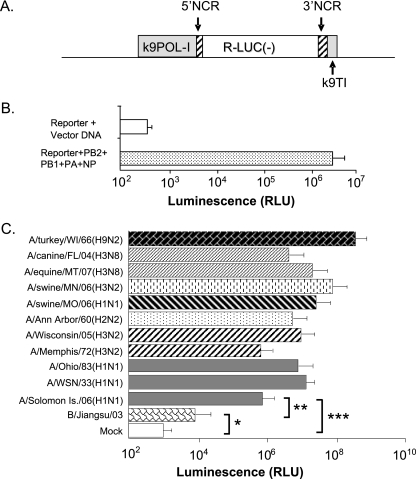FIG. 1.
Functional analysis of the influenza virus reporter amplicon with a canine polymerase I promoter in MDCK cells. (A) The negative-sense Renilla luciferase [R-LUC(−)] coding region is flanked by modified noncoding regions (NCR; hatched boxes) from the nucleoprotein gene of A/WSN/33 virus (24, 30). The sequences of the canine POL-I promoter and the canine Pol-I terminator (k9POL-I and k9TI, respectively; gray box) were fused upstream to the 5′ NCR or downstream to the 3′ NCR, respectively. (B) MDCK cells were cotransfected with reporter plasmid pk9POLI-RLuc and influenza virus RNP-expressing plasmids or control plasmid. RLU, relative light units. (C) MDCK cells transfected with pk9POLI-RLuc plasmid for 24 h were infected with influenza viruses at an MOI of 0.001. Luciferase activities in whole-cell lysates collected at 24 h postinfection are shown as the average of luciferase activity of cells from three independent wells. The values shown are the Renilla firefly activities from 104 cells after normalization using firefly luciferase expression from a cotransfected plasmid to account for variation in transfection efficiency. Error bars depict standard errors, and brackets denote P values from Student's t test: *, P > 0.9; **, P < 0.05; and ***, P < 0.005.

